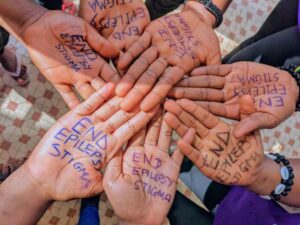
Courage Vidzengsi had her first epileptic seizure when she was eight. Jerking uncontrollably, she bit her tongue and fell to the ground at the children’s recreation centre. As her seizures became more frequent, her family took her from their home in the city of Bamenda back to her family’s village in Cameroon’s Northwest Region.
There they saw a traditional healer, known as a “Gambé man”, who would “cleanse” the young girl.
Vidzengsi recalls: “The cleansing process took three days. He brought a chick and dipped it in a calabash full of palm wine and instructed us to suck the feet. He mixed egusi [melon seeds] with fufu [mashed cassava] and oil, put it on leaves, and asked us to eat. Herbs and grasses were tied on our feet and hands.”
But her condition got worse, leading to another visit to a traditional health practitioner at a different shrine the following year. This time she was told to bathe naked in a river.
The prevalnce of epilepsy in the African continent is far higher than in the industrialised world. In Cameroon, rates are so high that it has now become a national public health concern, yet stigma arising from the belief that the condition is a “curse” poses a barrier to treatment.
Epilepsy is a non-communicable brain disease causing seizures that can lead to accidents or injuries. It affects about 50 million people globally, with nearly 80% of patients living in low-and middle-income countries, where they often have poor access to treatment.
Epilepsy has no identifiable cause or cure, but medication could allow many patients to live without seizures. However, traditional and religious beliefs in Africa hinder access to treatment.
In many parts of the continent, seizures are still seen as being caused by curses, demonic possession or witchcraft, leading people to seek remedies through prayer or traditional healers.
